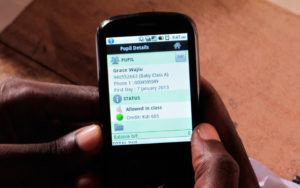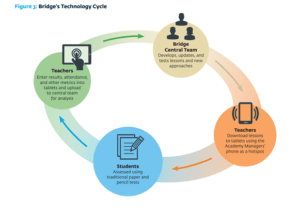Transforming the life cycle of education

Bridge International Academies uses technology to disrupt the lifecycle of education in low-income communities
Bridge International Academies’ mission is to provide high-quality, low-cost education for low-income families in developing countries. The organization has 100K students in 400+ schools across rural and suburban areas Kenya, Uganda, Nigeria, India, and Liberia. To achieve its mission, the company relies heavily on technology and digitalization to lower costs and improve quality – creating a unique operating model to provide education in low-income communities.To ensure quality, maintain control and facilitate communication the company leverages following:
Smartphones and customized app: Academy managers are provided with smartphones that are loaded with a custom-developed application that connects the managers to a central cloud-based server [1]. This application serves as a finance and operations management tool for the manager which he/she can use to upload and track admissions information, billing data, fee payments, expenses, payroll, attendance etc. It simplifies the operations for the manager, improves data collection and tracking as well as frees up the manager’s time to engage with parents and teachers. It also provides the central team with real time as well as time series data to help track, monitor and improve academy performance.

Teacher Tablets: Bridge also uses teacher tablets to increase the quality of teaching as well as accountability in the classroom. The central team creates and sends weekly teaching modules and lessons to the schools via its central servers. Teachers download these lessons to their tablets by connecting to the servers using the academy manager’s smartphone as a hotspot [1]. These centrally developed modules help ensure high quality of lessons, which would otherwise be highly dependent on each individual teacher. The center also receives a lot of valuable data from these devices – when a teacher checks in to class, how well the teacher is pacing through a lesson, student comprehension. and test scores. Using this, they can make both real time as well as long-term interventions and improvements. If a teacher doesn’t check in on his device, the center follows up and deploys a substitute teacher to the required academy. Data on delivery time, student comprehension, and test scores is sent back to the company’s academic specialists who use this information to revise and improve content and lessons going forward. [1] Thus, allowing them to have their eyes on the ground in all 400+ academies at the same time. Student test score data is also analyzed across academies to see which schools and teachers are performing better than the others.

Mobile money: Bridge also uses M-PESA a mobile phone-based money transfer to increase transparency across the system. Parents pay their pupils fees via M-PESA accounts and can see their payment status update real time on the academy manager’s phone. This increases the parent’s trust that their fees are not being ‘stolen’, as well as allows the central team to minimize fraud and pilfering on the ground.
Hence, we can see that Bridge as leveraged technology and big data in its business and operating model to drive scale and provide access to high quality and affordable education to underserved communities. [5]
Going forward, I think the organization could also consider leveraging informational and communication technologies (ICTs)[2] not only to simplify and drive operating decisions but also as a tool to drive student learning. One of the biggest requirements in today’s workforce is computer literacy and if Bridge can equip students in low-income communities with this skill, they will be able to dynamically transform the global workforce. I realize that given the communities their service, access to a stable internet in and electricity is a significant barrier to scaling of large-scale ICT literacy programs. However, there are several companies in the space that are developing innovative solutions, and Bridge could consider partnering with them. MobiStation in Uganda is an example of one such firm that has created a multimedia tool built into a portable suitcase, with a solar powered laptop, a low-power projector, and an audio system. It is loaded with offline content, that can be used without the need for internet access [3].
They could also consider leveraging their data collection process as well as their database on student performance to help drive hypothesis testing based changes to education policy and curriculum. Governments and education ministries in the countries in which they operate would find this information invaluable as they might not have the infrastructure set up themselves to test, evaluate and get such real-time feedback.
Word Count [727]
[1] http://www.bridgeinternationalacademies.com/wp-content/uploads/2016/09/Bridge-IFC-Case-Study-1.pdf
[2] http://blogs.worldbank.org/edutech/education-technology-poor-rural
[4] http://www.bridgeinternationalacademies.com/
[5] http://www.wsj.com/articles/startup-aims-to-provide-a-bridge-to-education-1426275737
[6] http://www.educationinnovations.org/program/bridge-international-academies



I see that they provide tablets to the teachers, but what about the students? Perhaps they could partner with an organization like World Reader that provides e-readers to children all over the world. May also be a better way to track student performance metrics.
http://www.worldreader.org/
very informative article. However, I was wondering about whether they are utilizing their tech infrastructure properly. With resources such as Khan Academy and Coursera, this company can take utilize their tablets and computers to train their teachers in delivering quality education. Moreover, literacy problem in several developing countries comprise people having graduated from schools without developing basic numeracy and verbal skills. For instance, literacy rate in India is at 74%, but it counts everyone who can just read and write sentences. UNESCO, on the other hand, defines it as
“ability to identify, understand, interpret, create, communicate, compute and use printed and written materials associated with varying contexts. Literacy involves a continuum of learning in enabling individuals to achieve their goals, to develop their knowledge and potential, and to participate fully in their community and wider society.”
Therefore, this company can have a real impact in its student’s lives if it leverages its IT network not just to monitor teachers’ attendance but also train them so that they deliver superior learning experience for their students.
http://unesdoc.unesco.org/images/0013/001362/136246e.pdf